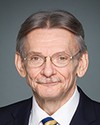Thank you for the question.
The best way to contextualize the difference between the F-35 fifth-generation and all the other platforms that are out there--which are great platforms--is that the F-35 brings a whole different set of skills to any conflict. The big difference is the way the airplane integrates information. The platform itself--the air frame or the airplane itself--doesn't have any extra magical powers. It can turn as well as other airplanes, but as far as manoeuvring and dogfighting are concerned in the traditional sense, other airplanes are also very good.
Where it really earns its paycheque is in that sensor suite that it brings to any fight or any conflict. The awareness bubble that this aircraft can project out is significantly different from anything else that's out there. Also, the big advantage of this aircraft is that it networks. I'm not sure if people are familiar with a version of Star Trek that had an entity called the Borg, a being that had a semi-human, mechanical sort of minds. The point was that whatever the lowest soldier saw, the collective saw, and vice versa.
The F-35 is very much in that network-centric world, where any airplane that sees anything out there can instantly share that information with all other airplanes on that network, and that works laterally. That's the big shift from what we do right now with our F-18s, which are great airplanes. We have a data link system that allows us to share some information, but it's still labour intensive. The pilot still has to manipulate sensors, collect information, make sense of it, and then post it on those links. The links are also detectable.
With the F-35 the big game changer is the way it reaches out for information, gathers it, makes sense of it, and presents it to the pilot without the pilot having to worry about it. It is transparent. All the sensors inter-operate—they talk to each other. If they don't have enough information, they'll reach out and go find it through the other network sensors. This is where this airplane operates on a different level from what we see currently on the market, and therefore projects a net of information that's massively larger than what we can do right now.




